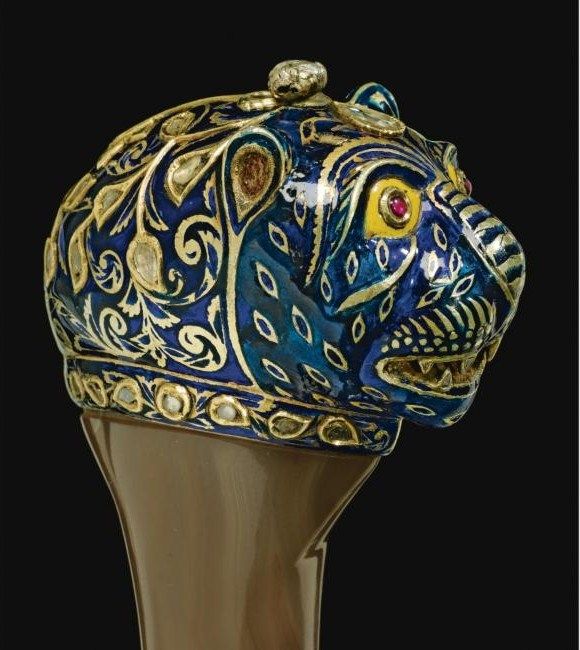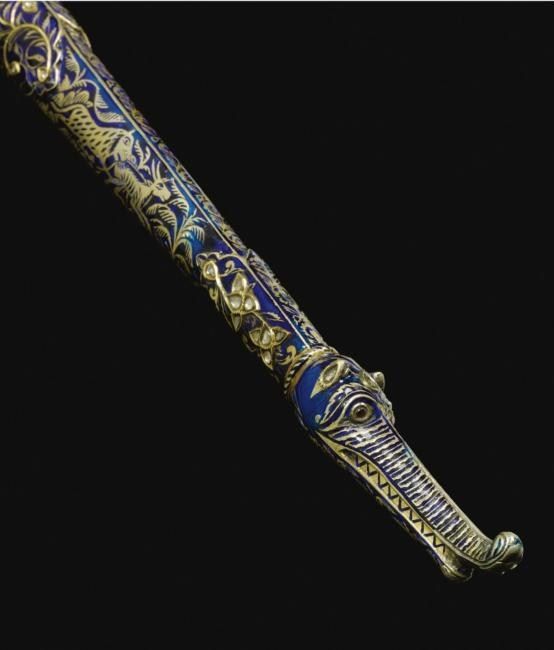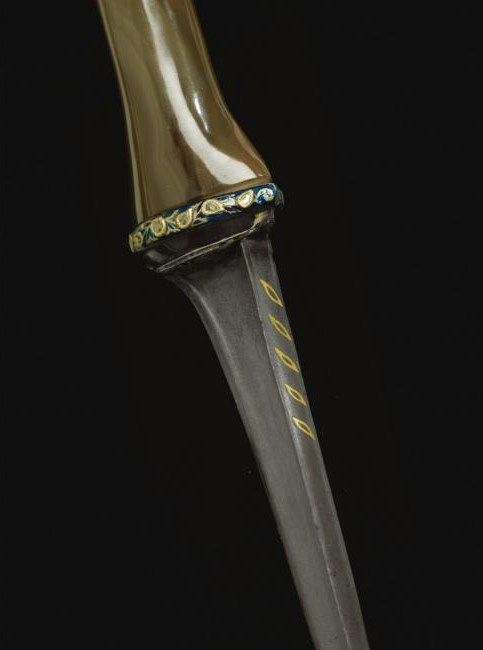
 |
|
|||||||
 |
|
|
Thread Tools | Search this Thread | Display Modes |
|
|
#1 |
|
Member
Join Date: Aug 2006
Posts: 608
|
So 2011 has so far been a pretty good year on the collecting front. But a couple weeks ago, I had the chance to pick up what I believe to be one of my best finds of the year...
This was the "crown jewel" in a moderate-sized local collection, a brass-hilted sosun pattah I believe dates to the mid-18th century (or thereabouts). The old collection tag reads, "Sosun Patta -- from Mysor, S. India." However, in sharing this with a couple forumites, both a possible Deccan and Rajput attribution have been discussed as well. The sword measures about 78 cm in length. The blade is of wedge-shaped, triangular cross-section, and measures 67 cm long and 3.5 cm in width for the length of the blade until it swells at the forward curve. There is a false edge that extends 26 cm from the (armor-piercing) tip. The ricasso measures 5.4 cm. There is a cartouche, in Urdu I think, on the obverse (pics below). But IMO the real gem is the brass hilt. The iconography incorporates Hindi makara and Mughal floral chiseling with what appears to be a Mysore bubri motif on the sides of the (face of the) zoomorphic pommel, styled in the form of what looks like a makara-stylized tiger (or tiger-stylized makara?). The figural quillons are also of makara form, though the figural langlets lack the distinctive upturned snout present on the quillons and the pommel, and to my eye they appear feline in form. The grip is divided into four panels, one panel covering the top, the bottom, and each side of the grip. The floral chiseling repeats on each panel. Anyway, I think it's a fine piece that exhibits the nuanced integration of the many cultural influences present in 18th century India. I'm hoping someone can assist with a translation of the (partial) cartouche in the hopes that it may help further assist in attributing this piece to a more specific time, place, or even person. In looking at (more than a few) references over the past couple of weeks, there definitely appears to be a significant deviation from the "usual" makara depiction, and the pointed (top-mounted) ears, bubri motif, and stripes on the back of the head all look distinctly tigerish to my eyes… I know the zoomorphic pommel & langlets are found on Lucknow hilts, but aren't Lucknow hilts usually enameled?  Anyway, I look forward to hearing your thoughts and observations… 
|
|
|

|
|
|
#2 |
|
Member
Join Date: Jul 2011
Location: Nashville
Posts: 314
|
Very nice, the blade reads Ya Allah یا الله pretty much meaning Oh Allah or Oh Lord.
|
|
|

|
|
|
#3 |
|
Member
Join Date: Oct 2006
Location: Warwickshire, England
Posts: 150
|
A lovely sword, I love these Zoomorphic pieces. I would describe the animal as a Makara, rather than a South Indian Yali. The south Indian Yali or Yarli, is much more grotesque, especially those from the Tamil Nadu area.
The Makara head pommel coupled with the mirrored Makara langets and qullion, is likely to be a flattering copy of those earlier swords produced in Mysore. We see this design regularly on late 19th Century South Indian brass hilted bichawas made in that area. My guess would be that this sword was late 18th Century or early 19th Century and from the Mysore or Deccan, possibly Hyderabad, this would lend itself well to the Islamic script on the blade. Regards, Runjeet Singh |
|
|

|
|
|
#4 | |
|
Member
Join Date: Aug 2006
Posts: 608
|
Quote:
Thanks, AJ... I'm posting a couple additional photos of the cartouche, including one in which I tried (with poor results) to reconstruct what appear to be two more characters in the cartouche. Pardon the poor reconstruction... 
|
|
|
|

|
|
|
#5 | |
|
Member
Join Date: Aug 2006
Posts: 608
|
Quote:
Hello Runjeet, Thank you for your input...  Interesting note, as the tag the former owner had attached also read, "Moslem Tipso Sultan or Hyder Ali" at the bottom (an obvious reference to Tipu Sultan, which I understood as an attribution of general time frame, not ownership). And it is encouraging to hear it might indeed have a S. Indian origin... Of all the pieces in my collection (including a Mysore or Tamil bichwa I found in a chor bazaar in Karnataka back in '97 or '99), my wife, who is from Bangalore, finally connected with this one. I've never seen her take to one of my pieces before, virtually drooling while turning it over in her hand like a pair of Manolo Blahnik's... 
Last edited by laEspadaAncha; 21st October 2011 at 02:27 AM. Reason: for clarity... |
|
|
|

|
|
|
#6 | |
|
Member
Join Date: Jul 2011
Location: Nashville
Posts: 314
|
Quote:
|
|
|
|

|
|
|
#7 |
|
Member
Join Date: Oct 2007
Posts: 2,818
|
A lovely piece and thanks for sharing.
In particular I like the thickened tip, a nice aspect not often shown. Gav |
|
|

|
|
|
#8 |
|
Member
Join Date: Dec 2004
Location: Europe
Posts: 2,713
|
Ok, I seem to be alone with my opinion on the Sossun Pata, as I don’t believe it is from Deccan or Hyderabad, and nor do I believe it was Tipu’s pillow sword – yes, I know that no one claimed that it is.
The marks at the side of the head are not Bubris they are Cintamani markings. These Cintamani marks were used a lot in Ottoman Empire and in Persia for decoration, and also in countries under Persian influence – the Mughal Empire. I believe it to be Rajasthani. The fact that the hilt is made of brass does not mean it is from Deccan, as brass hilts were also made in Rajasthan and even in Afghanistan. It is true that they more often used brass hilts in Deccan, but that is not any proof. The floral decoration on the hilt is to me more Rajasthani than it is Deccani, and the fact that the pommel and the ends of the quillons are Makara heads, points more to Rajasthan than to Deccan. The Makara, a fable amphibian animal, was used far more to the north than in Deccan, where they mostly used the fable ‘tiger/lion’ Wyali/Yali/Yarli. To this comes that the blade is from the north with its reinforced tip. It is difficult to judge the age from a picture, but my guess would be 18th to early 19th century. Jens |
|
|

|
|
|
#9 |
|
Member
Join Date: Aug 2006
Posts: 608
|
AJ - Thanks again for both the partial translation and for the attempted read of my (bad) reconstruction...
 Gav - Thanks mate... I'm including below a photo of the thickened tip. Jens - Thank you for your input. For my own edification, are there examples of similar Cintamani motifs you can point me towards? A cursory search turned up nothing but tri-lobes and wavy lines, though by contrast, I've found examples of similarly-executed bubri motif...  I'm also curious about the stripes (in the form of linear striations) that appear on the back of the makara head (and ears) - which I'll have to photograph and upload - and how (if at all) their appearance might affect your interpretation of the motif on the (sides of the) makara head. In the meantime, I've included another photo below with the area in question circled for the clarity of other forumites.  Cheers, Chris |
|
|

|
|
|
#10 |
|
Member
Join Date: Aug 2006
Posts: 608
|
Below is one of the examples I have found with a bubri motif I think resembles the motif on my own example (on the lateral surfaces of the pommel as circled above). It is the pommel of a pesh kabz that sold earlier this year at Sotheby's. Dated to ca. 1790, it is described as having a bubri motif with a possible Seringapatam attribution.
Also, one of the questions I have had is whether the styling of the makara may serve as a clue to the origin of the sword, given the variety of stylistic differences that seem to appear in the form. I also find it interesting that the styling of the makara (on the chape) appears to bare some resemblance to my example with regards to the pronounced nasal ridge and the ribbing...  Photos below... Bubri motif:  Makara chape:  Dagger:  Spine with recurring bubri:  Link to lot: Mysore Pesh Kabz ETA to add a photo showing the two motifs side-by-side: 
Last edited by laEspadaAncha; 22nd October 2011 at 06:59 AM. |
|
|

|
 |
|
|